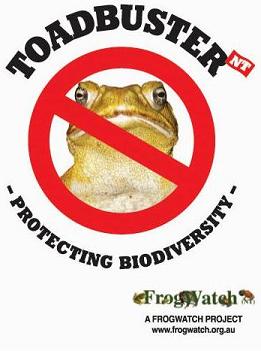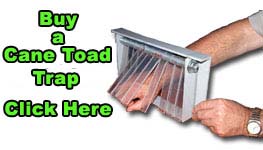Toad Busters
 ToadBusters is the name we have adopted for the project to try to stop toads overwhelming the ecosystems in and around Darwin and other places. ToadMusters are when people go out and collect toads at night. You can do this in your backyard or the local wetlands.
ToadBusters is the name we have adopted for the project to try to stop toads overwhelming the ecosystems in and around Darwin and other places. ToadMusters are when people go out and collect toads at night. You can do this in your backyard or the local wetlands.
We need you to help out. If enough people get involved we can stop toads!
What You Can Do
Register so we have your contact details and can keep you informed.
- Learn what a toad looks like and what they sound like. The call can be played from the FrogWatch website.
- Plan a strategy to keep your yard as toad free as possible using barrier fences, traps and manual collection. Have your traps set up when toads begin to arrive in your area. This strategy should also include removing eggs or tadpoles from ponds.
- Participate in neighborhood ToadMusters and get your neighbors involved.
- Help with ToadMusters in other problem areas.
- Volunteer for other work with FrogWatch such as helping to staff a display.
FrogWatch believes it is possible to stop toads from dominating ecosystems and destroying native animals in areas where there are enough people. FrogWatch is confident that we can keep toad numbers at a manageable level in the built-up areas of Darwin and Palmerston and in the populated rural area.
Further we believe it is our responsibility to manage our local environment and to protect our native species.
It is our aim is to keep the toads at a low background level in our ecosystem and eradicate them wherever possible. Our research indicates that there are strategies that will work to stop toads overwhelming the local environment, and that they are particularly effective in local areas when people work together. Other places have achieved localised success in substantially reducing toad numbers through people power.
It takes five to seven years for toad numbers to peak in an area (based on southern conditions). FrogWatch believes if people actively intervene in the first and successive years, toad numbers will not get to the level where they overwhelm other species.
FrogWatch believes we have to try - or we will never know what species might have been saved.
The basics of our strategy are to
- minimise the number of toads breeding through the wet season, and
- reduce their numbers to a very low level, even local extinction during the dry season, so there is limited breeding the following year.
- protect and manage areas of habitat for native species, including breeding areas for native frogs .
The pressure needs to be kept on toads from the day they arrive in your area. It is when toad numbers are allowed to build up that they overrun an area completely. In areas where there are enough people we can stop the numbers from building to plague proportions.
What do you do?
Make the decision that you are not going to put up with toads in your yard and get a plan together to ToadBust your yard and help out with neighbourhood toadBusts as well. A trap is also a good way to keep toad numbers down and should be considered as a part of your strategy.
Trapping and Collection Control strategies
Toad behaviour
Mature toads are nocturnal and like open areas with lighting as they are primarily visual hunters. They also need lots of food. This means they will congregate in open areas, especially around lights to which insects are attracted at night. They can easily be collected or trapped because of this behaviour.
Toads cannot regulate their water loss and they need moisture to survive. This means that in our dry season the toad is more vulnerable, especially to trapping. As the environment dries the toad must remain close to water. Also, as insect numbers decrease, the toads get more and more hungry. By the end of the dry season they are hungry and must stay close to the remaining water. Traps and ToadMusters can be used to remove them.
Toads from surrounding bushland will move into watered areas, such as your garden, during the dry times. Trapping and collecting the toads will help to eliminate the population from the entire area.
When toads move into your area, they cannot breed without making lots of noise. Learn their call so you will recognise it. If we are vigilant and follow up on calling toads we can remove them, and their eggs and tadpoles, from local ponds.
ToadBusting
This method involves picking up cane toads and removing them from the area. The strategy can be used in your backyard or out in the bush. For more details check out the newsletters from the Kimberley toadBusters, residents from kununurra and the east kimberley, who together with their coordinatores Lee Scott-Virtue and Sarah Brett are slowing down the movement of cane toads on the "western front".
Traps
Traps can catch lots of toads. Our trials removed over 2500 toads from one area during 2005. Traps have also been quite effective in smaller trials run by FrogWatch. In two separate trial sites trapping has locally eradicated the toad population. As new toads move into the area they too were caught in the traps. There is a more detailed discussion about the best sorts of traps at the FrogInfo section of the FrogWatch website.
Plan where traps may be used on your property now, and set up a trap before the toads arrive.













